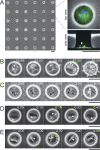Hematopoietic progenitors polarize in contact with bone marrow stromal cells in response to SDF1
- PMID: 34570198
- PMCID: PMC8479938
- DOI: 10.1083/jcb.202005085
Hematopoietic progenitors polarize in contact with bone marrow stromal cells in response to SDF1
Abstract
The fate of hematopoietic stem and progenitor cells (HSPCs) is regulated by their interaction with stromal cells in the bone marrow. However, the cellular mechanisms regulating HSPC interaction with these cells and their potential impact on HSPC polarity are still poorly understood. Here we evaluated the impact of cell-cell contacts with osteoblasts or endothelial cells on the polarity of HSPC. We found that an HSPC can form a discrete contact site that leads to the extensive polarization of its cytoskeleton architecture. Notably, the centrosome was located in proximity to the contact site. The capacity of HSPCs to polarize in contact with stromal cells of the bone marrow appeared to be specific, as it was not observed in primary lymphoid or myeloid cells or in HSPCs in contact with skin fibroblasts. The receptors ICAM, VCAM, and SDF1 were identified in the polarizing contact. Only SDF1 was independently capable of inducing the polarization of the centrosome-microtubule network.
© 2021 Bessy et al.
Figures








Comment in
-
The staying power of hematopoietic stem cells.J Cell Biol. 2021 Nov 1;220(11):e202109019. doi: 10.1083/jcb.202109019. Epub 2021 Oct 18. J Cell Biol. 2021. PMID: 34661601 Free PMC article.
References
-
- Alakel, N., Jing D., Muller K., Bornhauser M., Ehninger G., and Ordemann R.. 2009. Direct contact with mesenchymal stromal cells affects migratory behavior and gene expression profile of CD133+ hematopoietic stem cells during ex vivo expansion. Exp. Hematol. 37:504–513. 10.1016/j.exphem.2008.12.005 - DOI - PubMed

